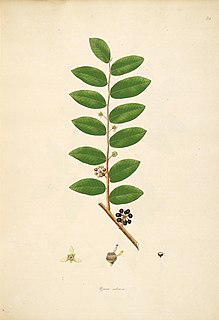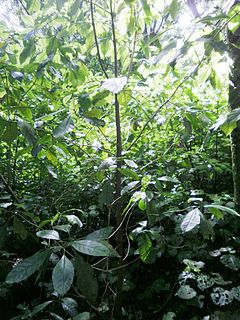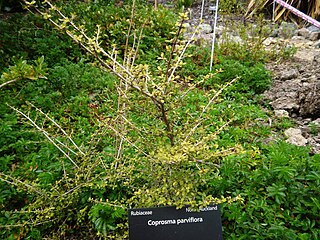
Coprosma robusta, commonly known as karamu, is a flowering plant in the family Rubiaceae. It can survive in many climates, but is most commonly found in coastal areas, lowland forests, or shrublands. Karamu can grow to be around 6 meters tall, and grow leaves up to 12 centimeters long. Karamu is used for a variety of purposes in human culture. The fruit that karamu produces can be eaten, and the shoots of karamu are sometimes used for medical purposes.

Coprosma is a genus of flowering plants in the family Rubiaceae. It is found in New Zealand, Hawaiian Islands, Borneo, Java, New Guinea, islands of the Pacific Ocean to Australia and the Juan Fernández Islands.
Stinkwood, german Stinkholz, french Bois Puant, is the common name for a number of trees or shrubs which have wood or plant parts with an unpleasant odour, including:

Polyalthia is a genus of flowering plants in the family Annonaceae. There are approximately 90 species distributed from Africa to Asia and the Pacific.

Smythea is a genus of plants in the family Rhamnaceae. It includes eleven species found in southeast Asia and Polynesia.

Coprosma repens is a species of flowering shrub or small tree of the genus Coprosma, in the family Rubiaceae, native to New Zealand. Common names include taupata, tree bedstraw, mirror bush, looking-glass bush, New Zealand laurel and shiny leaf.

Coprosma rhamnoides is an endemic shrub in New Zealand. It forms a small shrub up to 2 m tall. The leaves are very small, simple and variable in shape. The inconspicuous flowers are unisexual and believed to be wind pollinated. It is widespread in occurrence and can be the dominant small leaved divaricating shrub in some locations

Coprosma propinqua is a New Zealand plant of the genus Coprosma in the family Rubiaceae. Its Māori name is mingimingi, a name which is also applied to closely related species such as C. dumosa, C. rhamnoides, C. virescens and C. crassifolia. It is a small-leaved shrub or tree which grows 3 to 6 metres high. It has divaricating branches, and is common in swampy forest, in scrub, along stream banks and in stony places. It has a wide distribution, ranging from Mangonui in the North Island as far south as Stewart Island. It grows from sea level to 460 metres.

Coprosma quadrifida is a dioecious shrub of the family Rubiaceae native to southeastern Australia. First described as Canthium quadrifidum by Labillardiere, it was given its current name by B. L. Robinson in 1910. Typically found at damp sites within woodlands, Eucalyptus forests or cool-temperate rainforests, it prefers sheltered slopes or sites near water sources. They are able to withstand frost and are salt tolerant. The species is also known as the Prickly Currant Bush.

Coprosma nitida, the mountain currant or shining currant, is a shrub species endemic to south-east Australia. It is a shrub with small, glossy leaves, occasional spines on the end of its branchlets, and small bright red-orange fruits.

Coprosma petriei, commonly mirrorplant, is a mat-forming shrub native to New Zealand, Polynesia, Australia, the Juan Fernández Islands and Hawaiʻi. It is a hardy wind pollinated plant that is 0.1 m (4 in) by 0.5 m (20 in). Seeds mature in August and the plants only produce either male or female seeds; they are not self-fertilizing.

Coprosma perpusilla, commonly known as creeping coprosma, is a species of flowering plant in the family Rubiaceae. It is found in Australia, New Zealand and on some subantarctic islands. The specific epithet comes from the Latin per (very) and pusillus, referring to the growth habit.

Coprosma autumnalis, is a native forest shrub of New Zealand. Its widespread in both the North and South Islands, and has the largest leaves of any New Zealand coprosma.

Coprosma foetidissima, commonly known as stinkwood or hūpiro, is a shrub native to New Zealand.

Coprosma macrocarpa, also known as large-seeded coprosma and coastal karamu, is a shrub native to New Zealand. It has large thick leaves and large bright red/orange berries. Macrocarpa means "large fruit".

Coprosma parviflora, also called leafy coprosma, is a shrub that is native to New Zealand. C. parviflora naturally occurs on the Three Kings Islands and in the northern North Island.
Coprosma fowerakeri is a species of Coprosma found in the South Island of New Zealand described in 2003. It was previously included within C. pseudocuneata.
Anthospermeae is a tribe of flowering plants in the family Rubiaceae and contains 208 species in 12 genera. Its representatives are found in the Southern Hemisphere. At least two genera, namely Coprosma and Galopina are anemophilous.













